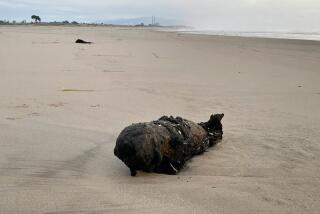Navy Will Remove Arsenic at O.C. Base
- Share via
The U.S. Navy will spend about $2 million to remove arsenic-tainted soil from a portion of the former Tustin Marine helicopter base where development is planned.
The contaminated dirt, brought to the base as backfill for the construction of two buildings in the 1970s, is on less than five acres scheduled to be turned over to Tustin in 2006, said Jerry Dunaway, the Navy’s environmental coordinator for the base.
The 1,600-acre Tustin Marine Corps Air Station closed in 1999, and the city plans to redevelop the base with 4,600 housing units, stores, light-industrial uses and parks.
In May, ground was broken on the first 376 homes to be built at the base.
So far, the Navy has spent $50 million to clean up jet fuel, solvents and other industrial waste at the former base -- 1,100 acres of which have been turned over to Tustin for development. An additional 200 acres, including the contaminated site, also are to be turned over to the city. Most of the remaining acreage was auctioned to developers by the Navy to help pay for the cleanup.
“We have 1,100 acres that are clean enough for residential use,” said Dana Ogdon, program manager for Tustin’s redevelopment agency. “A lot of former bases around the country will never get to that point. So we feel very fortunate.”
City and Navy officials have known about arsenic contamination on the five-acre site since 2001, when tests found concentrations of the toxic metal that were, on average, about twice as high as occur in nature.
At that level, the soil is not an immediate danger but must be removed before redevelopment can begin, officials said.
“It’s fairly shallow, about 2 to 4 feet deep,” Ogdon said of the contaminated soil. “The Navy’s committed to cleaning it up before the transfer” to the city.
Arsenic is used in a variety of commercial products, including insecticides and glass.
A draft report on a cleanup plan is expected to be ready in November.
Because the arsenic hasn’t contaminated ground water, officials said the site could be scraped clean and the toxic soil sent to a landfill by fall 2004.
More to Read
Sign up for Essential California
The most important California stories and recommendations in your inbox every morning.
You may occasionally receive promotional content from the Los Angeles Times.










